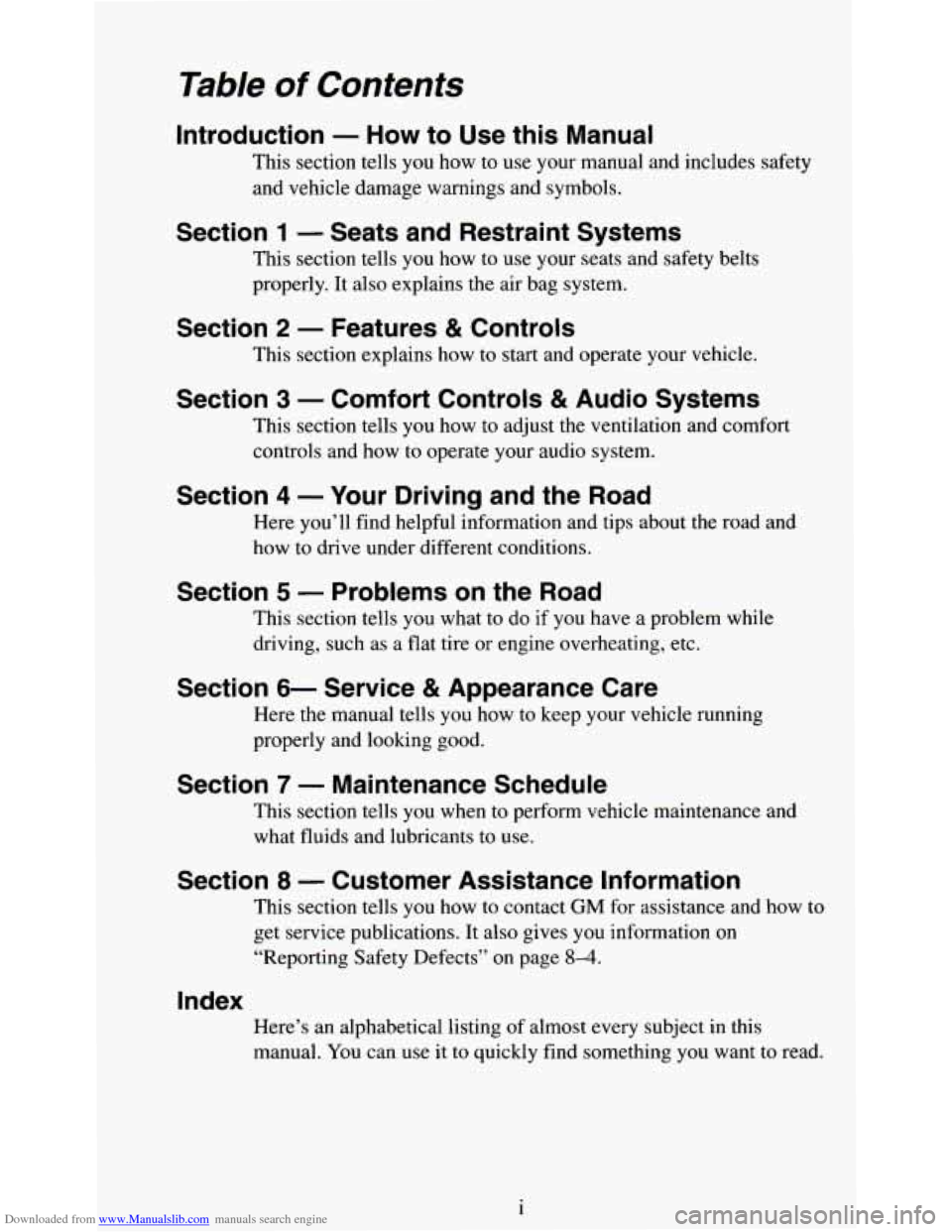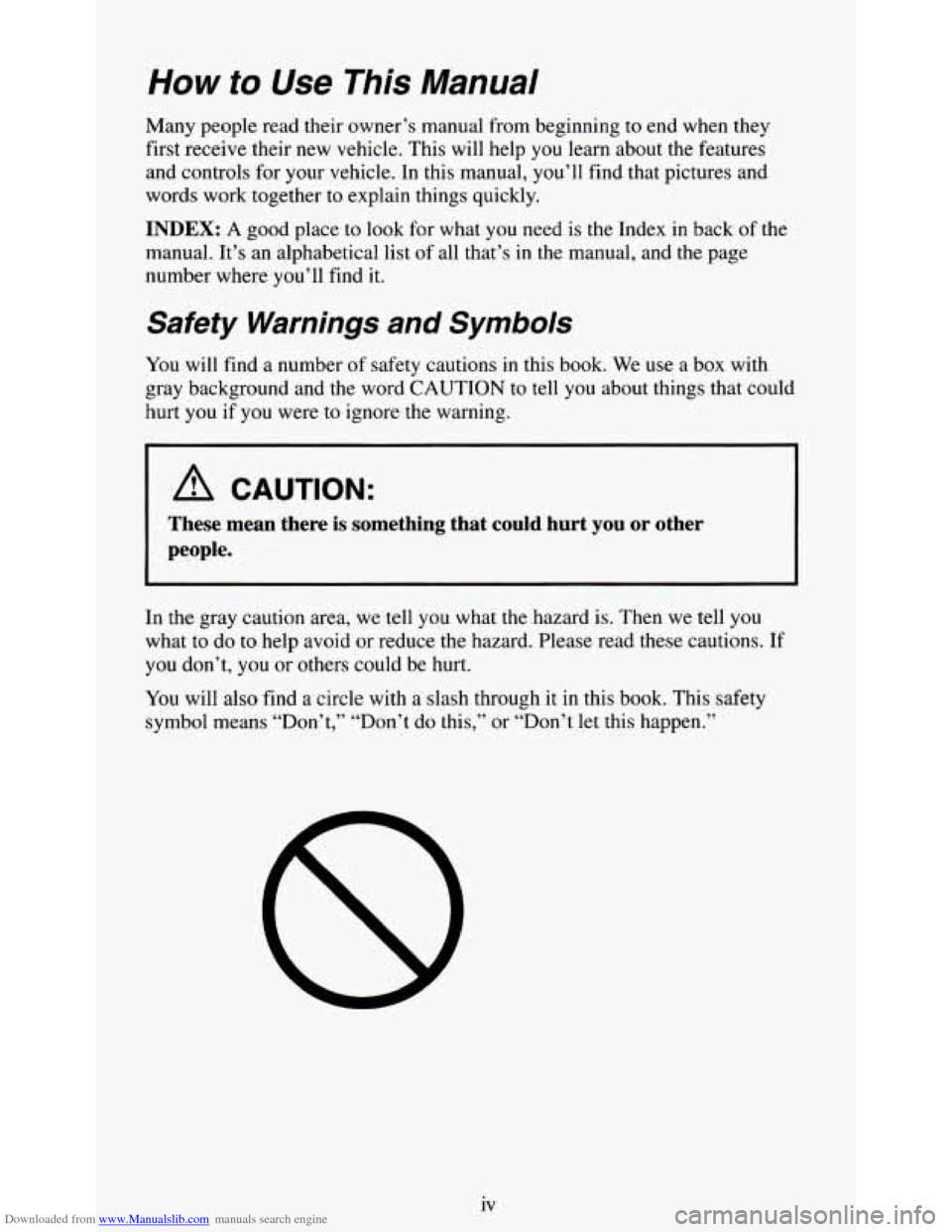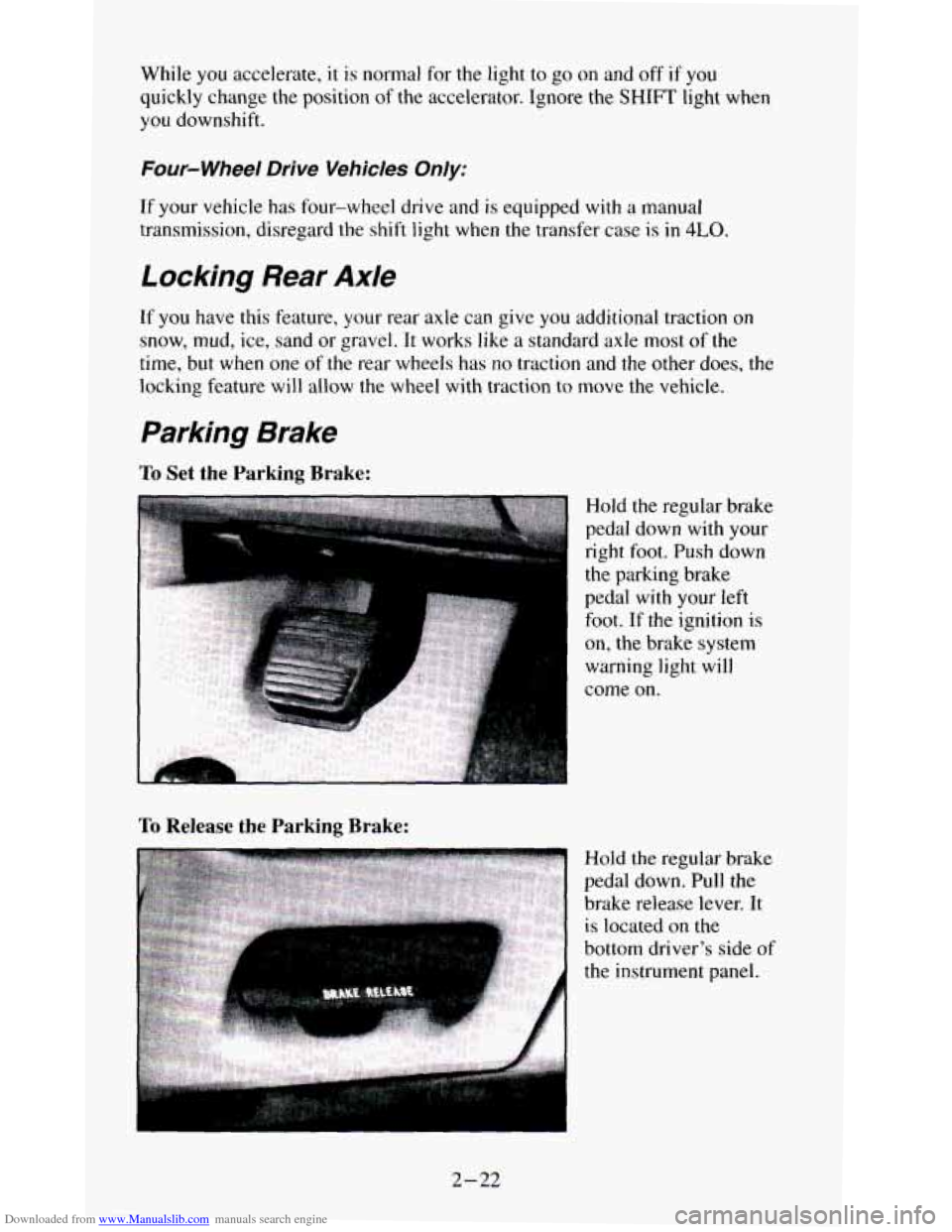Page 2 of 354

Downloaded from www.Manualslib.com manuals search engine Table of Contents
Introduction - How to Use this Manual
This section tells you how to use your manual and includes safety
and vehicle damage warnings and symbols.
Section 1 - Seats and Restraint Systems
This section tells you how to use your seats and safety belts
properly. It also explains the air bag system.
Section 2 - Features & Controls
This section explains how to start and operate your vehicle.
Section 3 - Comfort Controls & Audio Systems
This section tells you how to adjust the ventilation and comfort
controls and how to operate your audio system.
Section 4 - Your Driving and the Road
Here you’ll find helpful information and tips about the road and
how to drive under different conditions.
Section 5 - Problems on the Road
This section tells you what to do if you have a problem while
driving, such as a flat tire or engine overheating, etc.
Section 6- Service & Appearance Care
Here the manual tells you how to keep your vehicle running
properly and looking good.
Section 7 - Maintenance Schedule
This section tells you when to perform vehicle maintenance and
what fluids and lubricants to use.
Section 8 - Customer Assistance Information
This section tells you how to contact GM for assistance and how to
get service publications. It also gives you information on
“Reporting Safety Defects” on page
8-4.
Index
Here’s an alphabetical listing of almost every subject in this
manual. You can use it to quickly find something you want to read.
1
Page 5 of 354

Downloaded from www.Manualslib.com manuals search engine How to Use This Manual
Many people read their owner’s manual from beginning to end when they
first receive their new vehicle. This will help
you learn about the features
and controls for your vehicle. In this manual, you’ll find that pictures and
words work together to explain things quickly.
INDEX: A good place to look for what you need is the Index in back of the
manual. It’s an alphabetical list
of all that’s in the manual, and the page
number where you’ll find it.
Safety Warnings and Symbols
You will find a number of safety cautions in this book. We use a box with
gray background and the word CAUTION
to tell you about things that could
hurt you if you were to ignore the warning.
A CAUTION:
These mean there is something that could hurt you or other
people.
In the gray caution area, we tell you what the hazard is. Then we tell you
what to do to help avoid or reduce the hazard. Please read these cautions. If
you don’t, you or others could be hurt.
You will also find a circle with a slash through
it in this book. This safety
symbol means “Don’t,” “Don’t do this,” or “Don’t let this happen.”
Page 6 of 354
Downloaded from www.Manualslib.com manuals search engine Vehicle Damage Warnings
Also, in this book you will find these notices:
NOTICE:
These mean that there is something that could damage your
vehicle.
In the notice area, we tell you about something that can damage your
vehicle. Many times,
this damage would not be covered by your warranty,
and it could be costly. But
the notice will tell you what to do to help avoid
the damage.
When you read other manuals, you might see CAUTION and NOTICE
warnings in different colors
or in different words.
You’ll also see warning labels on your vehicle. They use yellow for
cautions, blue
for notices and the words CAUTION or NOTICE.
Vehicle Symbols
These are some of the symbols you will find on your vehicle. For example,
these symbols are used on an original battery:
Cautron Protect Eyes Caustic Battery Acid Spark or Flame Could
Possible Injury
by Shielding Could Cause Burns Explode Battery
Avoid
Sparks
or Flames
V
Page 7 of 354
Downloaded from www.Manualslib.com manuals search engine These symbols are important for you and your passengers whenever your
vehicle
is driven:
Fasten Safety
Belts
Door LockNnlock
These symbols have to do with your lights:
I Master Lighting
Switch Turn
Signal
Direction
A
Hazard Warning
Flasher Headlight
High Beam
Parking Lights Daytime
Running Lights
- Fog Lights Headlight
Low Beam
Vi
Page 8 of 354
Downloaded from www.Manualslib.com manuals search engine These symbols are on some of your controls:
Windshield
Washer Windshield
Defroster Windshield
Wiper
Ventilating
Fan
These symbols are used on warning and indicator lights:
Engine Coolant Battery Charging Fuel Temperature System
SHIFT
Brake Shift Light Anti-Lock
Brake
0
Off
Engine Oil
Pressure
vi i
Page 46 of 354
Downloaded from www.Manualslib.com manuals search engine Features & Controls
Section
Here you can learn about the many standard and optional features on your
vehicle, and information on starting, shifting and braking. Also explained
are the instrument panel and the warning systems that tell you if everything
is working properly - and what to do if you have a problem.
Keys
2- 1
Page 67 of 354

Downloaded from www.Manualslib.com manuals search engine While you accelerate, it is normal for the light to go on and off if you
quickly change the position of the accelerator. Ignore the SHIFT light when
you downshift.
Four- Wheel Drive Vehicles Only:
If your vehicle has four-wheel drive and is equipped with a manual
transmission, disregard the shift light when the transfer case is in
4LO.
Locking Rear Axle
If you have this feature, your rear axle can give you additional traction on
snow, mud, ice, sand or gravel. It
works like a standard axle most of the
time, but when one
of the rear wheels has no traction and the other does, the
locking feature will allow the wheel with traction
to move the vehicle.
Parking Brake
To Set the Parking Brake:
To Release the Parking Brake:
Hold the regular brake
pedal down with your
right
foot. Push down
the parking brake
pedal
with your left
foot. If the ignition is
on, the brake system
warning light will
come on.
Hold the regular brake
pedal down. Pull the
brake release lever.
It
is located on the
bottom driver's side
of
the instrument panel.
2-22
Page 100 of 354
Downloaded from www.Manualslib.com manuals search engine Trip Odometer
Standard Cluster
The trip odometer can tell you how far your vehicle has been driven since
you last set the trip odometer to zero. Make sure the button is completely
depressed.
TO set the trip odometer to zero, completely push the button near the
readout.
Tachometer
The tachometer displays the engine speed in revolutions per minute (rpmj.
Each tachometer has
a different limit depending on the powertrain in your
vehicle. The tachometer has three areas: normal operating range, red
warning range, and red danger range.
2-55